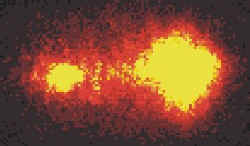Amplifier from Half-Breed Particles

The “se” in “laser” stands for “stimulated emission,” the critical property of photons that makes possible the huge amplification of energy inside a laser. In the 14 February PRL a team of European physicists reports “stimulated scattering” for polaritons–amalgams of electrons and photons that can exist only within a semiconductor–suggesting that a laserlike device could be made with these particles. The work could lead to fast switches, fast optical lasers, and possibly the creation of a polariton equivalent of a Bose-Einstein condensate.
To make an exciton-based polariton, researchers start by aiming a pulse of light at a thin layer of semiconductor material to create electron-hole pairs, or excitons. After a short time, each exciton self-destructs, as its electron and hole combine and emit a photon. But if the semiconductor is surrounded by mirrorlike materials forming a highly reflective cavity of the right size, the photon remains trapped and creates another exciton, which repeats the cycle. With this continuous dance between a photon and an exciton, “you get a new particle which is half light and half matter,” explains Jeremy Baumberg of the University of Southampton in the UK. “It actually has new properties.”
There has been some debate over the nature of polaritons and whether they do indeed act as new particles, clearly distinguished from their components. Some theorists, for example, suggest that polaritons should behave like bosons, including the ability for one particle to draw others into its quantum state, as photons do in a laser. Baumberg and his colleagues have now demonstrated this property for polaritons, and they say it’s the first direct evidence of bosonlike properties for particles in a solid.
The team was able to control the momentum of polaritons by changing the angle of the laser beams with respect to the semiconductor film. Their experiments involved two light pulses: First, a powerful pump pulse at a specific glancing angle created a sea of polaritons with a certain momentum; then, within 5 picoseconds, a small probe pulse aimed head-on at the film created a few more polaritons with zero momentum. Baumberg and his colleagues found that the probe pulse was amplified by up to 50 times, because the zero-momentum polaritons drew so many of the higher momentum ones down to their lower-energy state, before they all decayed into a flash of light. “You’re controlling a whole lot of these polaritons with just a few,” says Baumberg, with a process called stimulated scattering, which is related to the stimulated emission that leads to laser amplification.
If polaritons are truly bosons, then theoretically they could form the equivalent of a Bose-Einstein condensate (BEC), where particles gather en masse in the ground state, coalescing into a single quantum entity. Such a state could be the first BEC to be observed in a solid, although there have been other hotly disputed claims of solid-state BEC’s made only of excitons. Just as BEC’s of atoms in recent years have led to the “atom laser,” the team imagines a polariton-based laser, one that could switch on and off much faster than conventional semiconductor lasers.
David Citrin of Washington State University in Pullman says the work is “by far the clearest evidence” so far of bosonic properties for polaritons. He points to the team’s demonstration that the amount of amplification depends exponentially on the intensity of the pump–a dependence expected for stimulated scattering but inconsistent with more mundane explanations of the effect. Ted Norris of the University of Michigan in Ann Arbor agrees, but he notes that significant technical obstacles remain before the team’s amplifier can be turned into a laser, which is “the big future challange,” he says.


